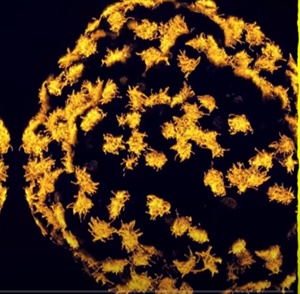A team of scientists from the University of Vermont, Tufts University, and the Wyss Institute for Biologically Inspired Engineering, all from the United States, has created self-replicating living robots, building further on their earlier success in developing the world's first living robot - Xenobots.

The Xenobots have now been seen to reproduce themselves by gathering hundreds of single cells together, and creating their own baby version inside their mouth.
Unveiled in 2020, Xenobots were formed from the stem cells of the African clawed frog (Xenopus laevis), from which they take their name. These tiny blobs that are less than a millimetre wide, were already capable of moving and working in groups and self-healing.
The same group of scientists have now discovered that the bots can reproduce themselves, but in an entirely different way than known among plants or animals.
"These are frog cells replicating in a way that is very different from how frogs do it. No animal or plant known to science replicates in this way," says Sam Kriegman, PhD, the lead author on the new study, in a report by Science Daily.
The Xenobots were originally created by scraping living stem cells from frog embryos. They were then left to incubate. After this, the cells were cut and reshaped into specific "body forms."
Stem cells are unspecialised cells that have the ability to develop into different cell types. To make the Xenobots, the researchers scraped living stem cells from frog embryos and left them to incubate. There was no manipulation of genes involved.
The cells later started to work on their own. The skin cells combined to form a structure. These pulsing heart muscle cells enabled the robot to move on its own. Little did the scientists know that the the Xenobot, once after it became a parent, was capable of forming a sphere.
"People have thought for quite a long time that we've worked out all the ways that life can reproduce or replicate. But this is something that's never been observed before," says co-author Douglas Blackiston, PhD, the senior scientist at Tufts University.
Co-author and a computer scientist at the University of Vermont, Josh Bongard said they found that the xenobots, which were initially sphere-shaped and made from around 3,000 cells, could replicate. But it happened rarely and only in specific circumstances. The xenobots used "kinetic replication" - a process that is known to occur at the molecular level but has never been observed before at the scale of whole cells or organisms, Bongard said.
With the help of artificial intelligence, the researchers then tested billions of body shapes to make the Xenobots more effective at this type of replication. The supercomputer came up with a C-shape that resembled Pac-Man, the 1980s video game. They found it was able to find tiny stem cells in a petri dish, gather hundreds of them inside its mouth, and a few days later the bundle of cells became new Xenobots.
The parent rotates a large ball of stem cells that is maturing into a new xenobot.
"The AI didn't programme these machines in the way we usually think about writing code. It shaped and sculpted and came up with this Pac-Man shape," Bongard said.
"The shape is, in essence, the programme. The shape influences how the xenobots behave to amplify this incredibly surprising process."
While the Xenobots are very early technology, this combination of molecular biology and artificial intelligence could potentially be used in a host of tasks in the body and the environment, say the researchers. This may include things like collecting microplastics in the oceans, inspecting root systems and regenerative medicine.
While the prospect of self-replicating biotechnology could spark concern, the researchers said that the living machines were entirely contained in a lab and easily extinguished, as they are biodegradable and regulated by ethics experts.
The research was partially funded by the Defense Advanced Research Projects Agency, a federal agency that oversees the development of technology for military use.
"There are many things that are possible if we take advantage of this kind of plasticity and ability of cells to solve problems," Bongard said.
The study was published in the peer-reviewed scientific journal PNAS on Monday.














.jpg)






.jpg)









